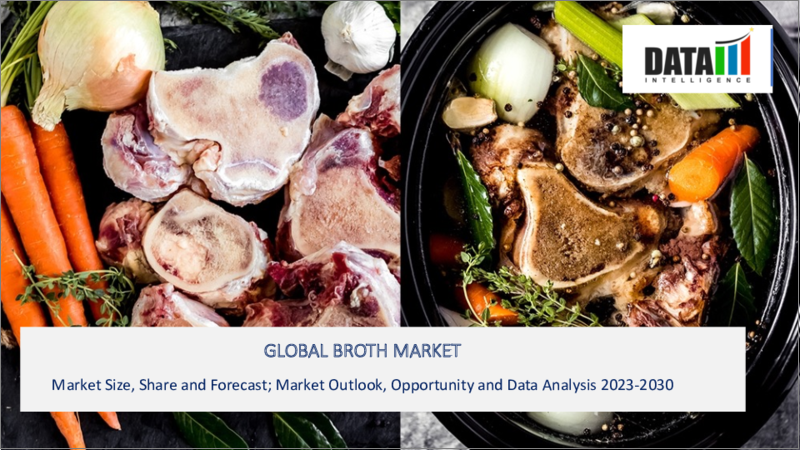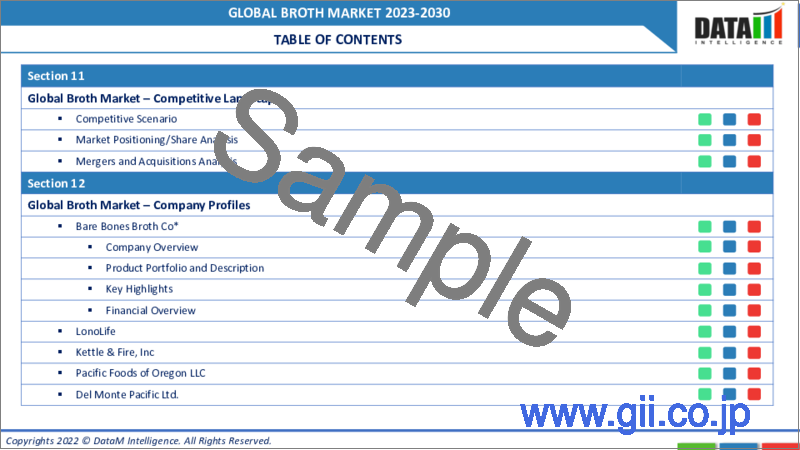|
|
市場調査レポート
商品コード
1304589
ボーンブロスの世界市場-2023年~2030年Global Bone Broth Market - 2023-2030 |
||||||
カスタマイズ可能
適宜更新あり
|
|||||||
| ボーンブロスの世界市場-2023年~2030年 |
|
出版日: 2023年07月07日
発行: DataM Intelligence
ページ情報: 英文 200 Pages
納期: 即日から翌営業日
|
- 全表示
- 概要
- 目次
市場概要
世界のボーンブロス市場は2022年に17億米ドルに達し、2030年には28億米ドルに達するなど、有利な成長が予測されています。予測期間2023-2030年のCAGRは6.5%です。
消費者は健康志向を強め、自然で栄養価の高い食品を求めるようになっています。ボーンブロスは、その高タンパク質含有量、コラーゲン、その他の有益な化合物により、栄養価の高い飲料として認識されています。基本的な栄養を超えた健康上のメリットを提供する機能性食品の人気が高まっています。ボーンブロスは、関節の健康、腸の健康、免疫サポートといった潜在的な効能がよく宣伝され、機能性食品の需要に合致しています。
伝統的な調理法や天然素材への関心が高まっています。ボーンブロスは、伝統的な調理法とシンプルで自然な原材料の使用がルーツとなっており、本格的で加工度の低い製品を求める消費者にアピールしています。ホールフードと低炭水化物摂取を重視するパレオダイエットやケトダイエットの人気も、ボーンブロスへの関心を高める一因となっています。ボーンブロスは、その栄養密度と低炭水化物含有量により、これらの食事療法に適合すると考えられています。
市場力学
健康意識の高まりがボーンブロス市場の成長を牽引
ボーンブロスは栄養価の高い自然食品とみなされることが多いです。動物の骨や結合組織を煮込んで作られ、コラーゲン、タンパク質、ミネラル(カルシウムやマグネシウムなど)、アミノ酸などの貴重な栄養素を放出します。健康志向の高まりとともに、消費者はこうした栄養価の高い食品を求めるようになっており、ボーンブロスはまさにその条件を満たしています。
ボーンブロスは、いくつかの潜在的な健康効果を持ちます。コラーゲンが豊富で、関節の健康、皮膚の弾力性、結合組織全体の健康をサポートする可能性があります。また、ボーンブロスに含まれるアミノ酸やミネラルは、腸の健康を促進し、消化を助け、免疫システムをサポートします。このような利点が消費者に認識されるにつれ、消費者はボーンブロスを食生活に取り入れるようになり、市場成長の原動力となっています。
体重管理に役立つボーンブロスの能力がボーンブロス市場の成長を促進
ボーンブロスはタンパク質が豊富で、満腹感を促進し食欲を減退させることが知られています。世界肥満連合が発表したWorld Obesity Atlas 2022によると、2030年までに世界で10億人(女性の5人に1人、男性の7人に1人)が肥満になります。バランスの取れた食事の一部として摂取すれば、ボーンブロスのタンパク質は食欲を抑え、食べ過ぎを防ぎ、最終的には体重管理の目標をサポートします。他の多くの伝統的なスープや汁物に比べて、ボーンブロスは比較的低カロリーです。
ボーンブロスに含まれるアミノ酸とゼラチンは、腸の内壁を癒し、密封する働きがあるため、消化に問題のある人には有益かもしれないです。健康な腸は、適切な栄養吸収と代謝に欠かせないです。腸の健康を改善することで、ボーンブロスは間接的に体重管理の努力をサポートします。
規制外の量のボーンブロスを消費することによる健康への悪影響は、ボーンブロス市場の成長を妨げる可能性があります。
規制されていない量のボーンブロスの消費は、健康に悪影響を及ぼす可能性があります。ボーンブロスはカルシウム、マグネシウム、リンなどのミネラルの重要な供給源となり得る。これらのミネラルは身体に不可欠であるが、ボーンブロスやその他の供給源を過剰に摂取するとバランスが崩れる可能性があります。特定のミネラルを大量に摂取すると、他の栄養素の吸収が妨げられ、腎臓結石やミネラルバランスの崩れといった健康上の問題を引き起こす可能性があります。
ボーンブロスは、特に自家製でなく、分量の調節ができない場合、ナトリウムを多く含む可能性があります。ナトリウムの過剰摂取は、高血圧の原因となり、心血管障害のリスクを高めます。腎臓病や高血圧などの特定の健康状態にある人は、ナトリウムの摂取を制限する必要がある場合があり、ボーンブロスを摂取する際には注意が必要です。
COVID-19影響分析
COVID-19分析には、COVID前シナリオ、COVIDシナリオ、COVID後シナリオが含まれ、価格力学(COVID前シナリオと比較したパンデミック中およびパンデミック後の価格変動を含む)、需給スペクトラム(取引制限、封鎖、およびその後の問題による需要と供給のシフト)、政府の取り組み(政府機関による市場、セクター、産業を復興させる取り組み)、メーカーの戦略的取り組み(COVID問題を緩和するためにメーカーが行ったことをここで取り上げる)が含まれます。
目次
第1章 調査手法と調査範囲
第2章 定義と概要
第3章 エグゼクティブサマリー
第4章 市場力学
- 影響要因
- 促進要因
- 抑制要因
- 機会
- 影響分析
第5章 産業分析
- ポーターのファイブフォース分析
- サプライチェーン分析
- 価格分析
- 規制分析
第6章 COVID-19分析
第7章 性質別
- オーガニック
- 従来
第8章 供給源別
- 鶏肉
- 牛肉
- 魚
第9章 用途別
- 強化食品・飲料
- 医薬品
- 栄養補助食品
第10章 流通チャネル別
- スーパーマーケット/ハイパーマーケット
- 専門店
- ドラッグストア
- オンライン販売
第11章 地域別
- 北米
- 米国
- カナダ
- メキシコ
- 欧州
- ドイツ
- 英国
- フランス
- イタリア
- スペイン
- その他欧州
- 南米
- ブラジル
- アルゼンチン
- その他南米
- アジア太平洋
- 中国
- インド
- 日本
- オーストラリア
- その他アジア太平洋地域
- 中東・アフリカ
第12章 競合情勢
- 競合シナリオ
- 市況/シェア分析
- M&A分析
第13章 企業プロファイル
- Bonafide Provisions
- 会社概要
- 製品ポートフォリオと説明
- 財務概要
- 主な発展
- Bare Bones Broth Co
- LonoLife
- Kettle & Fire, Inc
- Erie Bone Broth
- Left Coast Performance
- Pacific Foods of Oregon LLC
- Nutraholics
- Ancient Brand LLC
- Del Monte Foods Inc.
第14章 付録
Market Overview
The Global Bone Broth Market reached US$ 1.7 billion in 2022 and is projected to witness lucrative growth by reaching up to US$ 2.8 billion by 2030. The market is growing at a CAGR of 6.5% during the forecast period 2023-2030.
Consumers are becoming more health-conscious and seeking natural, nutrient-dense food options. Bone broth is perceived as a nutritious beverage due to its high protein content, collagen, and other beneficial compounds. Functional foods that offer health benefits beyond basic nutrition are gaining popularity. Bone broth is often touted for its potential benefits such as joint health, gut health, and immune support, aligning with the demand for functional foods.
There is a rising interest in traditional food preparation methods and natural ingredients. Bone broth, with its roots in traditional cooking and the use of simple, natural ingredients, appeals to consumers looking for authentic and minimally processed products. The popularity of the paleo and keto diets, which emphasize whole foods and low carbohydrate intake, has also contributed to the increased interest in bone broth. Bone broth is often considered compatible with these diets due to its nutrient density and low carbohydrate content.
Market Dynamics
Increasing Health Awareness is Driving the Bone Broth Market Growth
Bone broth is often regarded as a nutritious and natural food. It is made by simmering animal bones and connective tissues, which release valuable nutrients like collagen, protein, minerals (such as calcium and magnesium), and amino acids. With rising health consciousness, consumers are seeking out foods that offer these nutritional benefits, and bone broth fits the bill.
Bone broth is associated with several potential health benefits. It is rich in collagen, which may support joint health, skin elasticity, and overall connective tissue health. The amino acids and minerals in bone broth can also promote gut health, aid digestion, and support the immune system. As consumers become more aware of these benefits, they are incorporating bone broth into their diets, thereby driving market growth.
Ability of Bone Broth to Help with Weight Management is Driving the Bone Broth Market Growth
Bone broth is rich in protein, which is known to promote satiety and reduce appetite. According to the World Obesity Atlas 2022, which was released by the World Obesity Federation, 1 billion people worldwide, including 1 in 5 women and 1 in 7 men, would be obese by 2030. When consumed as part of a balanced diet, the protein in bone broth can help control cravings and prevent overeating, ultimately supporting weight management goals. Compared to many other traditional broths or soups, bone broth tends to be relatively low in calories.
The amino acids and gelatin found in bone broth can help heal and seal the gut lining, which may be beneficial for individuals with digestive issues. A healthy gut is crucial for proper nutrient absorption and metabolism, which can impact weight management. By improving gut health, bone broth indirectly supports weight management efforts.
The Negative Health Impacts of Consuming an Unregulated Amount of Bone Broth Can Hamper the Bone Broth Market Growth
Consuming an unregulated amount of bone broth may have some negative health impacts. Bone broth can be a significant source of minerals like calcium, magnesium, and phosphorus. While these minerals are essential for the body, consuming excessive amounts of bone broth or other sources can lead to imbalances. High levels of certain minerals can interfere with the absorption of other nutrients and may contribute to health issues such as kidney stones or mineral imbalances.
Bone broth, especially if it is not homemade and lacks portion control, can be high in sodium. Excess sodium intake can contribute to hypertension (high blood pressure) and increase the risk of cardiovascular problems. People with specific health conditions, such as kidney disease or hypertension, may need to limit their sodium intake and should be cautious when consuming bone broth.
COVID-19 Impact Analysis
The COVID-19 Analysis includes Pre-COVID Scenario, COVID Scenario, and Post-COVID Scenario along with Pricing Dynamics (Including pricing change during and post-pandemic comparing it with pre-COVID scenarios), Demand-Supply Spectrum (Shift in demand and supply owing to trading restrictions, lockdown, and subsequent issues), Government Initiatives (Initiatives to revive market, sector or Industry by Government Bodies) and Manufacturers Strategic Initiatives (What manufacturers did to mitigate the COVID issues will be covered here).
Segment Analysis
The global bone broth market is segmented based on nature, source, application, and region.
Rich Flavor and High Protein of Beef Drives the Segment Growth
Depending upon the source, the bone broth market is divided into chicken, beef, fish, and others.
In 2022, the beef segment had the highest share in the bone broth market. Beef bone broth, with its rich flavor and numerous health benefits, is gaining popularity among consumers worldwide. The rising awareness of the health benefits associated with beef bone broth is expected to drive the growth of the beef segment. Beef bone broth is known for its high protein content, essential amino acids, and collagen, which promote joint health, digestion, and skin health.
Manufacturers are investing in product innovation to attract consumers and expand their market share. The introduction of new flavors, such as spiced beef bone broth or herb-infused variants, is likely to drive the growth of the beef segment. For instance, on May 25, 2023, Nutra Organics, a renowned health food brand, expanded its offerings with the introduction of a new line of Beef Bone Broth concentrates. This latest addition complements their existing range of powdered Beef, Chicken, and Veggie Bone Broths.
Geographical Analysis
Product Launch of Bone Broth Products in North America Region
There is a North America, including the United States and Canada, has seen a significant rise in the popularity of bone broth in recent years. Bone broth has gained traction among health-conscious consumers in North America due to its perceived nutritional benefits. Increasing awareness of the potential advantages of bone broth, such as its protein content, collagen content, and potential support for joint health and digestion, has contributed to its growing demand in the region.
Manufacturers are playing a vital role in ensuring the availability, quality, and safety of bone broth products in the market. On July 21, 2021, Kettle & Fire launched a regenerative bone broth range in the US. The new line comes in beef and chicken varieties and is made with only organic ingredients and no artificial ingredients, preservatives, or flavors. To stand out in a competitive market, bone broth manufacturers focus on product differentiation. They may offer unique flavors or variations of bone broth, such as organic, grass-fed, or low-sodium options. Some manufacturers also target specific dietary preferences, such as paleo or keto-friendly bone broth.
Competitive Landscape
The major global players include: Bare Bones Broth Co, LonoLife, Bonafide Provisions, Erie Bone Broth, Kettle & Fire, Inc, Left Coast Performance, Pacific Foods of Oregon LLC, Nutraholics, Ancient Brands LLC., Del Monte Foods Inc.
Why Purchase the Report?
- To visualize the global bone broth market segmentation based on nature, source, application, and distribution channel understand key commercial assets and players.
- Identify commercial opportunities by analyzing trends and co-development.
- Excel data sheet with numerous bone broth market-level data points all for segments.
- PDF report consists of a comprehensive analysis after exhaustive qualitative interviews and an in-depth study.
- Product mapping available as excel consisting of key products of all the major players.
The Global Bone Broth Market Report Would Provide Approximately 69 Tables, 67 Figures, And 200 pages.
Target Audience 2023
- Manufacturers/ Buyers
- Industry Investors/Investment Bankers
- Research Professionals
- Emerging Companies
Table of Contents
1. Methodology and Scope
- 1.1. Research Methodology
- 1.2. Research Objective and Scope of the Report
2. Definition and Overview
3. Executive Summary
- 3.1. Snippet by Nature
- 3.2. Snippet by Source
- 3.3. Snippet by Application
- 3.4. Snippet by Distribution Channel
- 3.5. Snippet by Region
4. Dynamics
- 4.1. Impacting Factors
- 4.1.1. Drivers
- 4.1.2. Restraints
- 4.1.3. Opportunity
- 4.1.4. Impact Analysis
5. Industry Analysis
- 5.1. Porter's Five Force Analysis
- 5.2. Supply Chain Analysis
- 5.3. Pricing Analysis
- 5.4. Regulatory Analysis
6. COVID-19 Analysis
- 6.1. Analysis of COVID-19
- 6.1.1. Scenario Before COVID
- 6.1.2. Scenario During COVID
- 6.1.3. Scenario Post COVID
- 6.2. Pricing Dynamics Amid COVID-19
- 6.3. Demand-Supply Spectrum
- 6.4. Government Initiatives Related to the Market During Pandemic
- 6.5. Manufacturers Strategic Initiatives
- 6.6. Conclusion
7. By Nature
- 7.1. Introduction
- 7.1.1. Market Size Analysis and Y-o-Y Growth Analysis (%), By Nature
- 7.1.2. Market Attractiveness Index, By Nature
- 7.2. Organic*
- 7.2.1. Introduction
- 7.2.2. Market Size Analysis and Y-o-Y Growth Analysis (%)
- 7.3. Conventional
8. By Source
- 8.1. Introduction
- 8.1.1. Market Size Analysis and Y-o-Y Growth Analysis (%), By Source
- 8.1.2. Market Attractiveness Index, By Source
- 8.2. Chicken*
- 8.2.1. Introduction
- 8.2.2. Market Size Analysis and Y-o-Y Growth Analysis (%)
- 8.3. Beef
- 8.4. Fish
9. By Application
- 9.1. Introduction
- 9.1.1. Market Size Analysis and Y-o-Y Growth Analysis (%), By Application
- 9.1.2. Market Attractiveness Index, By Application
- 9.2. Fortified Food & Beverage*
- 9.2.1. Introduction
- 9.2.2. Market Size Analysis and Y-o-Y Growth Analysis (%)
- 9.3. Pharmaceutical
- 9.4. Dietary Supplements
10. By Distribution Channel
- 10.1. Introduction
- 10.1.1. Market Size Analysis and Y-o-Y Growth Analysis (%), By Distribution Channel
- 10.1.2. Market Attractiveness Index, By Distribution Channel
- 10.2. Supermarkets/Hypermarkets*
- 10.2.1. Introduction
- 10.2.2. Market Size Analysis and Y-o-Y Growth Analysis (%)
- 10.3. Specialty Stores
- 10.4. Drug Stores
- 10.5. Online Sales
11. By Region
- 11.1. Introduction
- 11.1.1. Market Size Analysis and Y-o-Y Growth Analysis (%), By Region
- 11.1.2. Market Attractiveness Index, By Region
- 11.2. North America
- 11.2.1. Introduction
- 11.2.2. Key Region-Specific Dynamics
- 11.2.3. Market Size Analysis and Y-o-Y Growth Analysis (%), By Nature
- 11.2.4. Market Size Analysis and Y-o-Y Growth Analysis (%), By Source
- 11.2.5. Market Size Analysis and Y-o-Y Growth Analysis (%), By Application
- 11.2.6. Market Size Analysis and Y-o-Y Growth Analysis (%), By Distribution Channel
- 11.2.7. Market Size Analysis and Y-o-Y Growth Analysis (%), By Country
- 11.2.7.1. The U.S.
- 11.2.7.2. Canada
- 11.2.7.3. Mexico
- 11.3. Europe
- 11.3.1. Introduction
- 11.3.2. Key Region-Specific Dynamics
- 11.3.3. Market Size Analysis and Y-o-Y Growth Analysis (%), By Nature
- 11.3.4. Market Size Analysis and Y-o-Y Growth Analysis (%), By Source
- 11.3.5. Market Size Analysis and Y-o-Y Growth Analysis (%), By Application
- 11.3.6. Market Size Analysis and Y-o-Y Growth Analysis (%), By Distribution Channel
- 11.3.7. Market Size Analysis and Y-o-Y Growth Analysis (%), By Country
- 11.3.7.1. Germany
- 11.3.7.2. The UK
- 11.3.7.3. France
- 11.3.7.4. Italy
- 11.3.7.5. Spain
- 11.3.7.6. Rest of Europe
- 11.4. South America
- 11.4.1. Introduction
- 11.4.2. Key Region-Specific Dynamics
- 11.4.3. Market Size Analysis and Y-o-Y Growth Analysis (%), By Nature
- 11.4.4. Market Size Analysis and Y-o-Y Growth Analysis (%), By Source
- 11.4.5. Market Size Analysis and Y-o-Y Growth Analysis (%), By Application
- 11.4.6. Market Size Analysis and Y-o-Y Growth Analysis (%), By Distribution Channel
- 11.4.7. Market Size Analysis and Y-o-Y Growth Analysis (%), By Country
- 11.4.7.1. Brazil
- 11.4.7.2. Argentina
- 11.4.7.3. Rest of South America
- 11.5. Asia-Pacific
- 11.5.1. Introduction
- 11.5.2. Key Region-Specific Dynamics
- 11.5.3. Market Size Analysis and Y-o-Y Growth Analysis (%), By Nature
- 11.5.4. Market Size Analysis and Y-o-Y Growth Analysis (%), By Source
- 11.5.5. Market Size Analysis and Y-o-Y Growth Analysis (%), By Application
- 11.5.6. Market Size Analysis and Y-o-Y Growth Analysis (%), By Distribution Channel
- 11.5.7. Market Size Analysis and Y-o-Y Growth Analysis (%), By Country
- 11.5.7.1. China
- 11.5.7.2. India
- 11.5.7.3. Japan
- 11.5.7.4. Australia
- 11.5.7.5. Rest of Asia-Pacific
- 11.6. Middle East and Africa
- 11.6.1. Introduction
- 11.6.2. Key Region-Specific Dynamics
- 11.6.3. Market Size Analysis and Y-o-Y Growth Analysis (%), By Nature
- 11.6.4. Market Size Analysis and Y-o-Y Growth Analysis (%), By Source
- 11.6.5. Market Size Analysis and Y-o-Y Growth Analysis (%), By Application
- 11.6.6. Market Size Analysis and Y-o-Y Growth Analysis (%), By Distribution Channel
12. Competitive Landscape
- 12.1. Competitive Scenario
- 12.2. Market Positioning/Share Analysis
- 12.3. Mergers and Acquisitions Analysis
13. Company Profiles
- 13.1. Bonafide Provisions*
- 13.1.1. Company Overview
- 13.1.2. Product Portfolio and Description
- 13.1.3. Financial Overview
- 13.1.4. Key Developments
- 13.2. Bare Bones Broth Co
- 13.3. LonoLife
- 13.4. Kettle & Fire, Inc
- 13.5. Erie Bone Broth
- 13.6. Left Coast Performance
- 13.7. Pacific Foods of Oregon LLC
- 13.8. Nutraholics
- 13.9. Ancient Brand LLC
- 13.10. Del Monte Foods Inc.
LIST NOT EXHAUSTIVE
14. Appendix
- 14.1. About Us and Services
- 14.2. Contact Us





